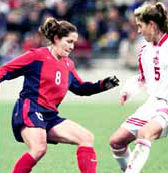Female ACL

A recent study has shown that 1 out of 10 female college athletes have had an Anterior Cruciate Ligament (ACL) injury at some point during their playing career. ACL injuries have been a common problem for women soccer players in the professional leagues. Studies have also indicated that females, who participate in sports that require cutting and jumping, were 5 times more likely to suffer serious knee injuries compared to their male counterparts. Most of these injuries are actually non-contact ones, which result from jump landings or pivoting on the knee. While various studies are currently underway to try and determine why females are showing a higher incidence of ACL injuries compared to males, some early results have lead to some theories for explaining the greater prevalence of ACL injuries in females. One theory is based on the anatomical differences between females and males.
Females generally have larger 'Q angles', which refers to the angles where the femur bone and tibia bone meets at the knee. The 'Q angle' is determined by the width of the pelvis. Having a larger 'Q angle' means that there is a greater susceptibility of the knee to have an inward torque when an individual performs jumping, landing, turning, and planting movements. Another difference is posture related. Females tend to move around with less of a knee bend. When the knees are straight, the ligaments are in a position more vulnerable to injury. The muscles can stabilize the knees more effectively, when the legs have some bend. There is a related aspect to this postural straight knee position in females. A study performed at the Santa Monica Orthopedic Sports Medicine Research and Education Foundation showed that females tend to jump and land flat footed with their knees in extended positions when compared to males. This landing in an extended knee position is now considered a primary factor to the greater number of ACL injuries in females. Utilizing a proper jump training program that teaches soccer players how to jump and land correctly is a necessary component, which needs to be implemented to reduce the probability of ACL injuries. The goal is to minimize the chance that the athlete will end up in vulnerable positions, which result in knee injuries. The New Wave Soccer Conditioning Program includes instructions for using correct form in jumping and landing in the 'Female ACL Prevention' section. This section also provides specific jump training exercises for females to utilize. The other apparent significant factor for the greater number of ACL injuries in females is that they have less strength in the muscles surrounding the knee joint. More importantly, the ratio of strength between the Quadriceps and Hamstrings is not as close as it should be for females. The potential to suffer an ACL injury is increased when there is an insufficient Quadriceps/Hamstrings strength ratio. Females, who have no prior strength training background, generally have even a greater imbalance of strength between the Quadriceps and Hamstrings. The New Wave Soccer Conditioning Program addresses this muscle balance concern, and recommends a few modifications for female soccer players to ensure optimal muscle balance to reduce injury potential. This includes both a greater emphasis on Hamstrings to Quadriceps strength ratio and developing the VMO(inner quadricep) muscle. This section adds a few supplemental exercises to the base strength training program design for those needing to address these special needs. The knee stabilization and balance drills offered with the New Wave Soccer Conditioning program will decrease the risk of ACL injuries by helping to improve proprioception. Proprioception is a neurologic process. It is the awareness of body segment positions and orientations. Balance drills are used to improve proprioception by training the brain to recognize the segment position of the body at all times. Balance drills to improve proprioception are utilized for athletes, who are rehabilitating knee injuries. However, these drills can also be utilized by healthy athletes to decrease the risk of future injuries, by training proprioception pathways more effectively during athletic competition. Peripheral and central nervous system receptors, including mechanoreceptors within muscles, tendons, and ligaments need to be activated to help prevent knee injuries. Balance drills assist in making this activation happen faster and more effectively, which will reduce the time between neural stimuli and muscular response. So while these balance drills will help improve athletic performance, utilizing these drills on a frequent basis might also decrease the risk of knee injuries.
When a soccer player suffers a knee injury, he or she will either have surgery with follow-up therapy or choose non-surgery therapy to treat that injury. There is still going to be a certain amount of time lost to participate in soccer during the year, which could be several months to a year. This fact makes it even more vital for females to be aware of the potential risk for ACL injuries, and do what they can to minimize that risk. To obtain the essential training drills for ACL injury prevention and all other components of the New Wave Soccer Conditioning program, please click on the Sign Up link below or in the left column of this page.




